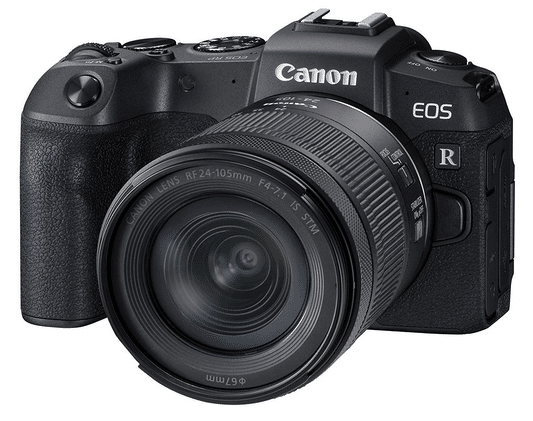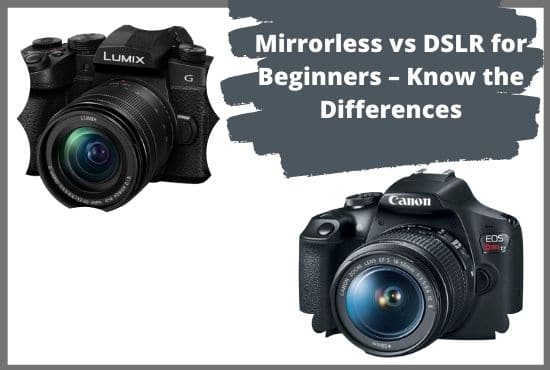As an Amazon Associate I earn from qualifying purchases.
The first DSLR came out in 1991 and it ruled the industry for more than two decades. But recently a new technology, namely Mirrorless cameras, are getting popular day by day. After the invention of Mirrorless cameras many reputed DSLR manufacturing companies like Canon, Nikon shifted towards Mirrorless cameras completely and didn’t release any DSLRs in over 3 years.
It may seem that the era of DSLR cameras is over as Mirrorless cameras are making their way in. But there are still many DSLR cameras that perform significantly better than Mirrorless cameras that come under the same budget range. Mirrorless vs DSLR for beginners is a debate going on for long and it is anything but over till the time.
Mirrorless cameras came out commercially some years ago, and in this short time, the technology got so matured that it is going toe to toe with a highly matured technology and outperforming it in many cases. Today we’ll try to get a brief overview of Mirrorless and DSLR cameras and try to come to a conclusion about which is best for beginners.
Contents
Mirrorless vs DSLR for Beginners- Comparison Chart
The comparison of Mirrorless and DSLR cameras is based on some key points, and without knowing those parts, it would be hard for anyone to understand these cameras’ functionalities. Getting familiar with those key points will make it easy for you to understand which one is better and you should purchase that one.

Content | Mirrorless Camera | DSLR Camera |
Size & Weight | Light and Compact | Heavy |
Autofocus Speed | Fast | Moderate |
Previewing Images | Electronic Viewfinder | Optical Viewfinder |
Image Stabilization | 5-axis Image Stabilization | 2-axes Image Stabilization |
Image Quality | Small image sensor | Large Image sensor |
Video Quality | Better than DSLR | Not as Good as Mirrorless Camera |
Shooting Speed | Faster | Slower than Mirrorless |
Battery Life | Less | More |
Lenses & Accessories | Less | Less |
Mirrorless VS DSLR- in Depth Discussion
On the above chart, we tried to give you an overview of Mirrorless and DSLR cameras features and functionalities. Let’s know about these briefly.
Size and Weight
The technology behind both DSLR and Mirrorless cameras is quite the same. In DSLR cameras, the image sensor is covered with a mirror, but in Mirrorless cameras, there is no mirror in front of the image sensor. Due to not having this mirror the size and weight of Mirrorless cameras are way less than DSLRs.
DSLRs are quite heavy in comparison to Mirrorless cameras that make it difficult to carry around. For having a compact design, you can carry more stuff inside a camera bag with Mirrorless than you could with DSLRs. The DSLRs cameras have a thick body than Mirrorless but the weight of both of these cameras are nearly the same.
For example, Nikon D5600 is a DSLR camera with 2.8 inch body thickness and weighs 1.4 pounds with a kit lens. While Sony a6100 a Mirrorless camera with 1.6 inch body thickness and 1.3 pound weight. So, a Mirrorless camera is compact enough to carry inside a coat’s pocket, but the weight of these cameras is pretty close.

Autofocus Speed
In the past the autofocus speed of DSLRs used to be greater than Mirrorless cameras. Mirrorless cameras used to use contrast detection technology for focusing which is pretty good in daylight but becomes laggy in low-light. Where the phase-detection technology of DSLRs was spot on and still provides impressive autofocus speed.
But as the Mirrorless technology matured , the company started to include both phase detection and contrast detection technology in the autofocusing system which increased the accuracy and speed of autofocusing by a greater number. So now Mirrorless has the advantage of autofocus speed in both day and low light.
The chip that processes the image data in Mirrorless cameras now includes both phase and contrast-detection points. For example, the Sony a6100 has 425 phase detention and 425 contrast-detection points.
Previewing Images
DSLRs offer an optical viewfinder through which you can see a preview of the image you are taking. The result the optical viewfinder provides is consistent in good and low lighting conditions. Most of the entry level Mirrorless cameras use its LCD screen as a viewfinder and high end Mirrorless cameras come with an electronic viewfinder.
The advantage of electronic viewfinder is that it will show the preview of an image how it will look after taking the pictures. Also, if you change the aperture or shutter speed, the result you see on the viewfinder will change accordingly. But in tricky low light situations, the result of the electronic viewfinder is not as good as the optical viewfinder.
Image Stabilization
Entry level DSLRs or Mirrorless cameras do not offer any type of image stabilization features. High-end DSLRs offer sensor-shift stabilization which minimizes small amounts of handshake effect while taking pictures or recording videos. The image sensor moves upwards/downwards or left/right in the opposite direction your hands are moving to counter the shakiness and provide a stable result.
Mirrorless cameras are capable of providing 5 axes image stabilization which can provide super steady videos. But the problem is, for getting these features you have to buy a super expensive Mirrorless camera which is not suggested for beginners. You can purchase a lens that comes with image stabilization to get stable footage.
Image Quality
In terms of image quality, both DSLRs and Mirrorless cameras can produce similar types of results. But entry-level DSLRs come with a larger image sensor than entry level Mirrorless cameras. When the comparison goes to high-end cameras, Mirrorless cameras perform superior. With a small image sensor, a Mirrorless camera can produce similar results as a DSLR by digitally and minimizing the noise. So, when Mirrorless gets a bigger image sensor, the result will be up to mark.
Many Mirrorless cameras now come with full-frame sensors with the same sensor size as high end DSLR. These cameras produce stunning quality photos. So, when choosing a camera, you should not be so concerned about image quality and the result you get from both of these types of cameras will be pretty much the same.
Video Quality
When a camera captures video, what it does is captures a series of photos. So, for a DSLR to capture a video it has to keep the mirror up the whole time it is capturing the video. Most entry level DSLR cannot use its phase detection autofocus while the mirror of the camera is being lifted up for a long time. It causes the camera to hunt for focus after using it for some time.
For videography DSLRs use the less accurate contrast-detection autofocusing system as most of the DSLRs do not have on-chip phase detection capability. Although Canon added on-chip phase detection technology on its mid level cameras like Canon 80D.
Mirrorless cameras on the other hand, comes with precise on chip phase detection autofocusing technology which gives the Mirrorless camera advantage in videography. For having superior autofocusing than DSLRs, the video quality of Mirrorless cameras are comparatively good.
The base models of Mirrorless cameras are also capable of 4K video recording while you may have to buy a mid range DSLR to get 4K video recording capability. For blogging and other jobs that demand video recording, Mirrorless cameras will be a good option for beginners.
Shooting Speed
Both types of cameras can shoot images pretty fast. Even if you are capturing a very fast moving object, you may not feel any difficulties capturing those. But the Mirrorless camera uses a mechanical shutter and it does not have a mirror so it can capture images faster than a DSLR. Although the difference in shooting speed in high-end cameras is negligible, for an entry level camera, you may feel the shutter lag on a DSLR in case of shooting a high speed object.
Battery Life
In most of the categories, DSLR and Mirrorless cameras perform very competitively but in battery life DSLRs are leagues ahead of Mirrorless cameras. Battery life is probably the only field that Mirrorless cameras are so much behind than DSLR.
An entry level DSLR is capable of capturing about 3 times more pictures on the same-size battery than an entry level Mirrorless camera. Mirrorless cameras consume so much battery that it uses its LCD screen all the time to show the live view of the images. The processing power consumes more battery as it uses an on chip autofocusing system. Also, electronic viewfinder contributes to the battery consumption.
The battery life of Mirrorless cameras is increasing but it is nowhere near the DSLR level. So, if you go for a Mirrorless camera you should consider buying an extra battery.
Lenses & Accessories
DSLR has the upper hand in the case of lenses and accessories as these have been around for a longer time than Mirrorless cameras. Canon and Nikon offer hundreds of lenses for their DSLR models which are of all categories. You can find lenses for DSLR that are budget-friendly, for professional work and lenses that are fancy and wildly expensive.
For all different types of photography needs, there are lenses for DSLR. But, the lens collections of Mirrorless manufacturers are fairly small. Most of these companies offer a limited number of lenses for Mirrorless cameras but the number is increasing day by day.
Third party companies offer lenses for DSLRs and Mirrorless but the number is very few for Mirrorless cameras. Not just lenses but also other accessories like Speedlight and other camera tools are also readily available for DSLRs.
Though there is a way of using DSLR lenses on Mirrorless is via using a third party lens adapter but often that causes you to lose things such as focal length, zoom and autofocus.
Final Thoughts
Mirrorless is the modern technology and it provides the user advantages in videography, compact and light to carry around and better autofocusing. But, it offers fewer lenses and accessories and the battery life is not that good.
DSLRs provide a better overall optical viewfinder, impressive battery life and a wide selection of lenses to choose from. For having a touchscreen and simple user interface, Mirrorless cameras are more user friendly and easy to operate as a smartphone.
In the comparison of Mirrorless vs DSLR for beginners, Mirrorless has the upper hand in many cases. Both these types of cameras are awesome and do not have that much of a difference, and you’ll feel the difference less if you are a beginner. Before buying any of these you should try one of each kind and which feels comfortable you should go for that. No matter what you choose, one thing for sure is that you’ll be able to capture beautiful and high quality pictures.
Also you can read : Can DSLR Lens Be Used in Mirrorless Camera
As an Amazon Associate I earn from qualifying purchases.

